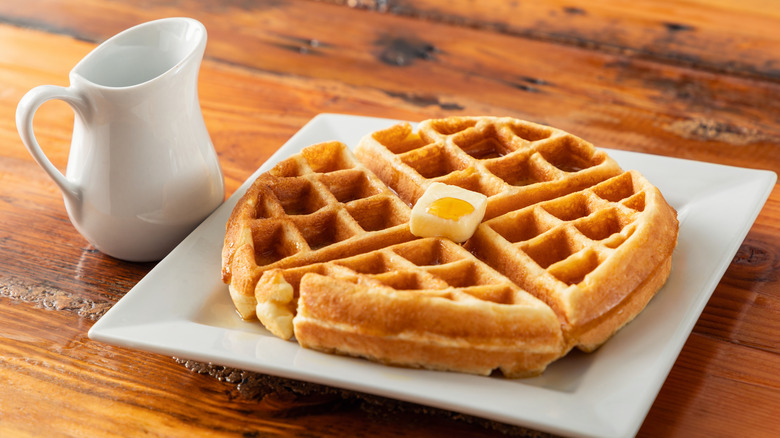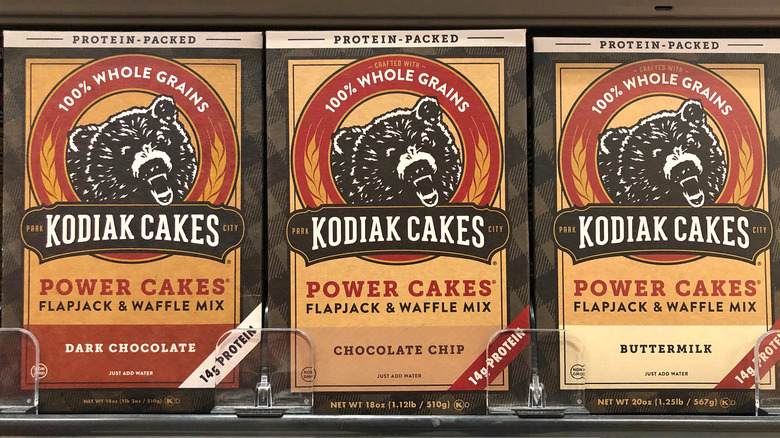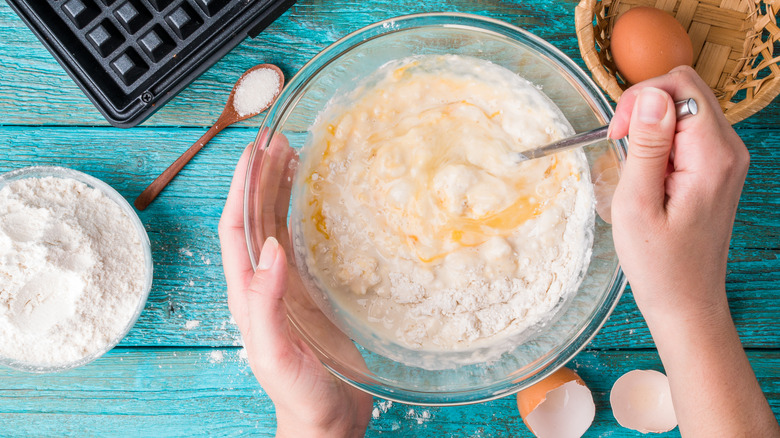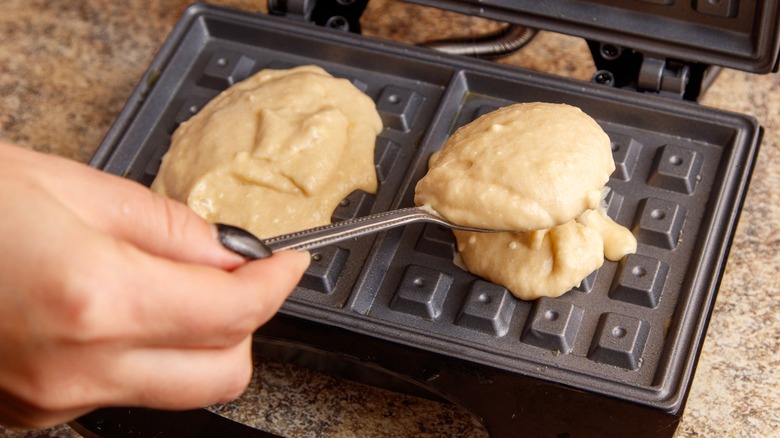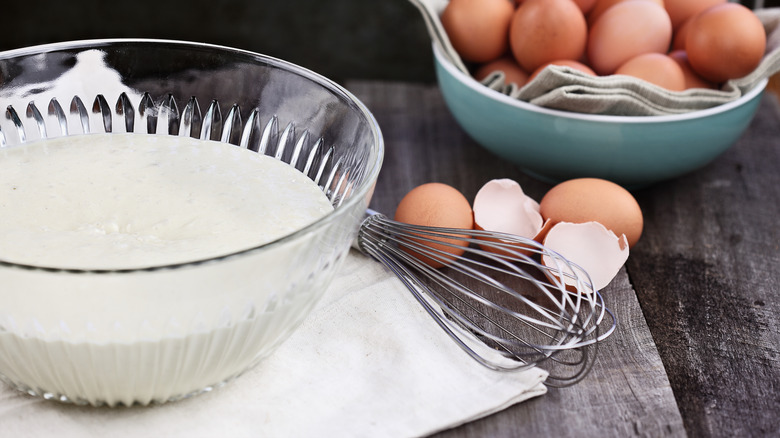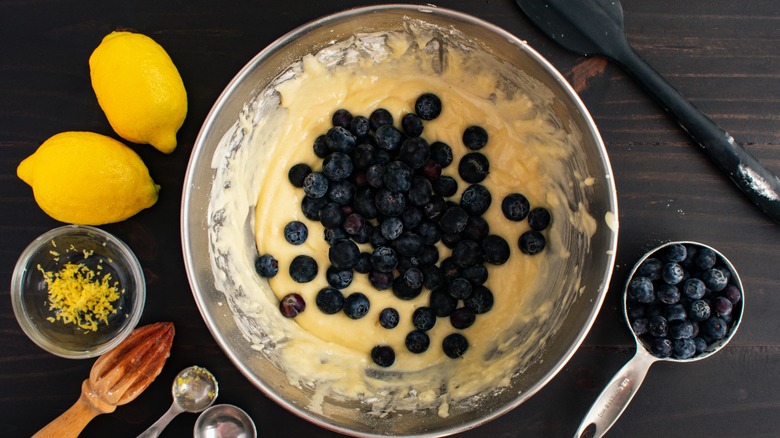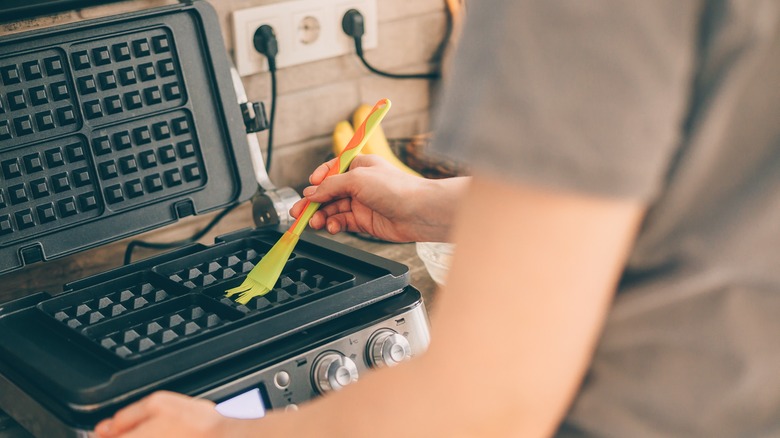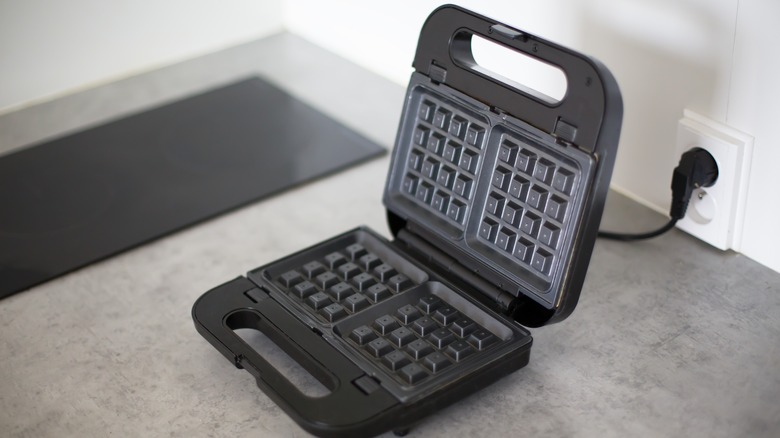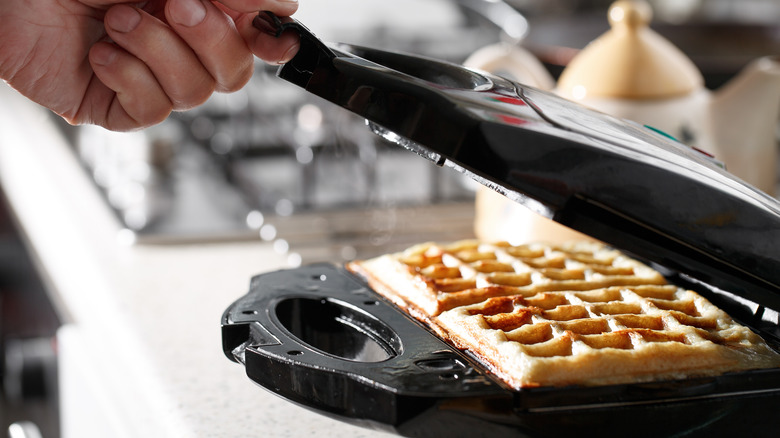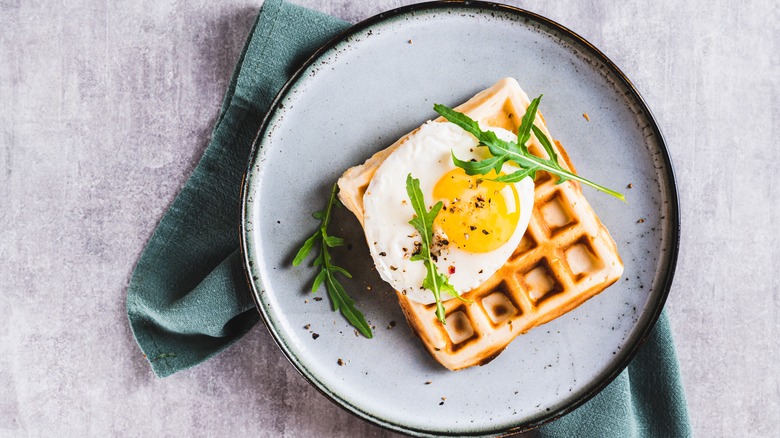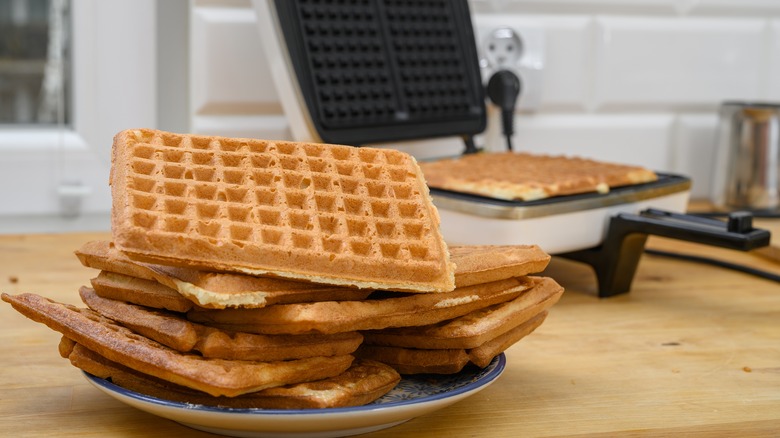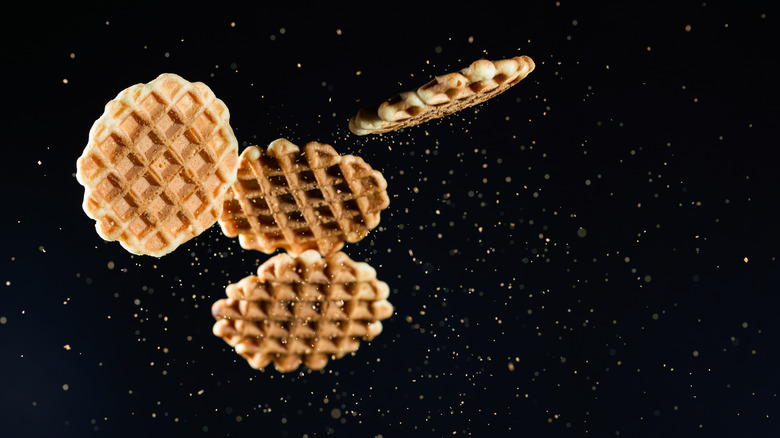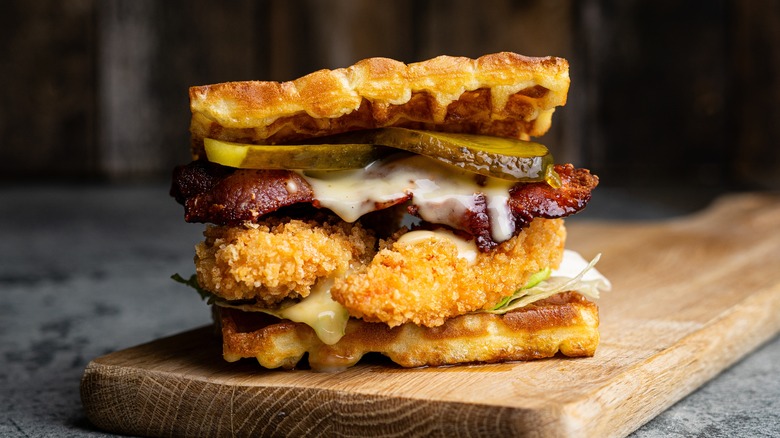15 Common Mistakes To Avoid When Cooking Waffles
Of all the breakfast items, waffles may be the most beloved. Who can say no to freshly griddled waffles slathered in warmed butter with their crisp, golden exterior and soft, fluffy interior? Whether you prefer yours topped with a delicate drizzle of syrup or heaped with fruit and dairy, these hot griddle cakes are hard to beat. Unfortunately, there are many ways to botch the job, leading to underwhelming waffles, such as those which are chewy, dense, or soggy.
Waffles such as these are no way to start the day. Be you making traditional buttermilk waffles or fashioning toad in the hole-style ones, there are many mistakes one should be wary of making. Yes, you can sidestep them all by taking the frozen waffle route, leaving your lonely waffle iron to gather dust. But where's the fun in that? It's time to bust out that waffle maker and do it justice, crafting a noble stack of the most sensational waffles that has ever graced your plate — all of which can only be done by avoiding these common pitfalls.
Being beholden to box mixes
Although boxed mixes are a great place to start, they have their limitations. Skip the box mix altogether to customize your waffles with your own signature ingredients like yellow cornmeal, or a dash of buckwheat or rye flour to give waffles a nuttier note. You can also substitute white whole wheat flour for regular white flour to add an extra dose of whole grains to the mix. Just be sure not to use pastry flour or bread flour. Bread flour possesses a higher amount of protein, rendering waffles far too heavy. By contrast, pastry flour is too dainty to be utilized in waffle-making. Stick to all-purpose flour for the best result, striking the perfect balance between lightness and strength.
If a boxed mix is your only available avenue, you can improve its blander qualities with the addition of a few ingredients. Consider adding a tablespoon or 2 of melted butter to waffle batter to improve the texture and add additional depth. Doing so will ensure the interior is nice and fluffy. Swapping water for buttermilk is another option. Buttermilk will imbue waffles with a subtly, tangy quality that will contrast nicely with sweet toppings, making your packaged waffle mix a little less basic.
Using just any recipe
It goes without saying that there's far more than one waffle recipe out there, but did you know there's more than one type of waffle? In America, you'll find two main varieties: Belgian-style waffles that use a yeast for leavening, and classic American-style ones that use baking soda or baking powder. And yet these are not all the types of waffles that exist. In Belgium, you'll find no such thing as a Belgian waffle; instead you'll find either Brussels waffles or Liege waffles. Belgian waffles, as we often refer to them here, are most similar to Brussels waffles. Liege waffles, dubbed after the city of Liège in the Walloon region of Belgium, are smaller and crispier. Made from something resembling a sweet brioche-esque dough more than a typical waffle batter, they possess a chewier texture, marked by a caramelized flavor due to the inclusion of pearl sugar.
They stand in marked contrast to the Brussels waffle, which is airier, larger, and softer than the denser Liege waffle. Featuring larger pockets for capturing a variety of toppings, Brussels waffles are differentiated by their crisp outsides and tender, light insides. For this reason, you may not wish to select just any waffle recipe you find. Yeasted waffles will require a proofing yeast that must sit overnight, so if you're hoping for a waffle recipe to make on demand, you'll want to steer clear of European recipes. Luckily, most modern Belgian waffle recipes found in the U.S. will be modified to include baking powder rather than yeast. Additionally, be aware that Belgian waffle recipes (or Brussels waffle recipes) often call for a larger waffle maker with deeper pockets.
Thinking waffle batter and pancake batter are the same thing
Despite what the store-bought box may tell you, pancake batter and waffle batter are not interchangeable. Think again before you pour leftover pancake batter into a waffle maker, as the two have many differences. Waffle batter is thicker and oftentimes contains more sugar, eggs, and butter than pancake batter. The additional sugar lends waffles their beautiful golden coloring as it caramelizes in response to the heat of the waffle iron. The excess fat found in the butter and eggs bestow additional richness and prevents the waffle from sticking to the iron. Pancake batter, by contrast, is thinner, containing a higher proportion of milk, and designed more for pouring.
If you do want to turn your favorite pancake batter into waffle batter, the recipe will require some modifications. The first step will be to mix in some added fat, going as far as to double the number that your pancake recipe asks for. To compensate, consider doubling the amount of butter called for. Secondly, add milk in place of water, opting for whole milk, if you desire, for a richer result. The addition of a little extra oil (like a tablespoon or 2 of vegetable oil) will also increase the fat content, helping to yield waffles with a crispy outside, and flavorful, delicate inside.
Making a heavy batter
Have you ever pulled a waffle from your waffle maker only to bite into a creation that seems all too dough-like? It could be due to an overly dense batter. Lightening your batter is an important step to avoid making heavy or dense waffles. Luckily, there are a few ways to lighten the mix. The most common involves separating your egg whites and yolks, then whipping the egg whites into a light, creamy state before folding them into the waffle mix. A second option is to add in some unsweetened cream that you've whipped.
The goal with both of these methods is to craft a lighter batter, resulting in exquisitely fluffy and airy waffles. Not up for a whipping frenzy this Sunday morning? Other recipes may include clear soda or seltzer to add lightness to waffle mix. The carbonation will oxygenate your waffle batter, helping to aerate the texture. Just substitute some sparkling water for some of the milk or water in your waffle recipe for extra fluffy results.
Preparing the waffle batter too soon
Unless your waffle recipe calls for yeast that requires proofing, you should never make batter ahead of time. Although it may sound convenient to make your waffle mix the night before for easy access in the morning, your waffles will suffer the consequences. Making the waffle batter before it is needed can result in waffles that are too heavy, as opposed to light and fluffy. Why is this? Non-yeasted waffle batters include baking soda as part of their dry ingredients. Once the wet ingredients mix with the dry, the batter will begin to rise, filling with air bubbles. These bubbly pockets of air are what lead to light, airy waffles as opposed to dense ones. However, if you make that batter and wait too long to use it, all those tiny bubbles will leave.
Ideally, you should whip up your batter to use immediately. If your recipe also contains baking soda, you'll have a few extra minutes, as baking soda reacts first to the added liquid, and second to heat. Still, it's best not to wait too long. If you are eager to save time in the morning, consider pre-mixing your dry ingredients beforehand to save time measuring and mixing. You can also pre-slice fruit or other toppings ahead of time, instead.
Assuming flavorings should only go on top
Did you think tasty additions were only for topping waffles? Think again. You can add complexity to your waffle batter by adding spices or other components right into the mix. Vanilla extract is a tried-and-true favorite for adding to pancake batter, as is a little dash of cinnamon. Try to use real vanilla extract as opposed to the artificial type for the best result, or consider using fresh vanilla beans. Nutmeg, allspice, and ginger are all wonderful additions for bestowing a little extra flavor to your batter, as well, imbuing the mix with a warming touch. But spices aren't the only flavorful tool in your arsenal.
Consider adding grated citrus zest for extra vibrancy, like that of lemon or orange. No fruit on hand? Add lemon oil to give waffle batter extra brightness. Looking for something more seasonal? Spoon in some pumpkin purée for fall-themed delights. For a nuttier medley, mix in almond extract or a handful of pecans. Like a little meat with your waffles? Try adding it straight to the batter. You can cook and crumble bacon or sausage to give waffles an extra savory boost. For lovers of fruit, add berries straight to the batter or try crushed pineapple. And don't forget about chocolate waffles. For this delightful concoction, add cocoa powder straight to the batter.
Believing nonstick is really nonstick
It won't matter how lovely your batter is if you let your waffle iron sabotage the morning. You should always grease your waffle iron, whether it claims to be nonstick or not. Spray with nonstick vegetable oil for a quick coating, or brush your iron with melted butter with a pastry brush for a remarkable result. As an added bonus, the butter will assist in coloring and crisping your waffles, lending them a beautiful golden hue.
Older waffle irons may need a little extra greasing to ensure no sticking occurs. Sadly, easily reached for spray-on products may not be able to provide the proper protection on these well-loved appliances. Instead, use either vegetable oil, butter, or your preferred fat to oil all your older iron's tiniest crevices. Doing so will help guarantee no bit of waffle is wasted.
Forgetting to preheat the iron
It goes without saying that you should never add waffle batter to a cold iron. Pre-heating is an important step, one which the novice waffle maker often rushes. Just remember, patience is vital, as adding the batter too soon will result in lackluster results. Pre-heating is a signature element in crafting griddle cakes which are evenly crisp and golden.
Try to always preheat the iron for 10 minutes or more, even if the waffle iron dings before then. Waffle maker sensors are unreliable, often alerting you when only one section of the iron has reached the appropriate temperature. It's important to wait until the entire iron is fully heated, which often takes longer. In addition, it is essential to let that waffle iron recover between uses. To make sure every waffle is as crispy and browned as the first, allow the iron to reheat for one to two minutes between uses to avoid mushy results.
Pulling ingredients straight out of the fridge
It's another element often forgotten in the rush of the morning madness, but it's integral not to use cold ingredients when making waffle batter. Wet ingredients blend together better if they are room temperature or warm. Additionally, adding melted butter to cold milk will only cause it to clot up leading to an uneven batter. Use this in your waffle maker, and you may end up with some bites chock-full of butter and others lacking in flavor. For these reasons, you should always let ingredients come to room temperature before mixing.
Yes, it may take a little longer to take the chill off your eggs and milk, but the end result will be worth it. Plus, you'll spend less time stirring the batter since the ingredients will mix more easily, saving your arm muscles for better uses (like, say, eating a pile of waffles).
Beating the batter instead of stirring
Although you might think a little extra stirring would lead to a smoother batter and softer waffles, the opposite is actually true. It may seem counterintuitive, but if you over-mix a waffle batter you could end up with a tougher waffle. Why? The less a batter or dough is worked, the less gluten development occurs, and less gluten development leads to softer waffles. For the softest, lightest waffles, stir the batter instead of beating it. Use a rubber spoon or spatula, not a whisk, mixing only enough to combine the ingredients.
Use a tender hand when mixing the batter, gently stirring it at a slow pace. Making waffles isn't a race, after all. Over do it and you may find yourself with a tough and chewy breakfast. Instead, take the slow and steady approach and you'll find yourself with fluffy waffles every time.
Letting impatience rule you
It's tempting when you can smell the crispy, sweet goodness right below to lift the lid and sneak a peek. But hoisting the lid too soon on your waffle maker will only prolong the time you need to wait for great waffles. Even worse, it can ruin their fluffiness or cause them to rip or stick. Avoid disastrous consequences, and don't lift the lid until the iron stops steaming — even if the ding tells you otherwise. Once you do finally open that top, the waffles before you should appear golden and exude that signature waffle smell.
Prefer your griddle cakes a little more browned? For fans of ultra crispy waffles, you can leave the lid closed for another 20 to 30 seconds after the steam stops escaping out the waffle maker's sides. This extra time will lead to perfectly, well-done waffles.
Viewing syrup as the only topping choice
Although maple syrup is a classic choice, it's far from the only waffle topping out there. Keep this signature breakfast dish novel by experimenting with new additions every now and again. Unsure of where to start? Consider branching out with the addition of honey, agave syrup, or jam for something simple. For a new twist on this sweet classic, try blending ricotta with maple syrup or lemon juice. Seasonal fruits are another exciting option. While blueberry waffles may be a time-tested dish, there are other fruity concoctions to enhance your waffle experience.
Try bananas or crisp, sliced apples for a fresh and nutritious bite. Give waffles a tropical spin with coconut and pineapple, or lend them a Mediterranean twist with figs and whipped goat cheese. Top with ham, béchamel, and a fried egg for croque madame waffles or slather with cottage cheese for a little extra protein. There are also more alternatives like lemon curd or yogurt sprinkled with granola. These creative possibilities and many more await you.
Allowing them to get chilly
It may not apply for those making a single waffle, but if you're feeding a flock, you'll need to keep those delicious creations warm as the rest are cooking. Don't let all your hard work go to waste by allowing those first few waffles to get cold while you build the stack. Instead, keep ready waffles nice and toasty in the oven. Simply set the oven to 200 F to keep completed waffles warm while you finish making the whole batch. Place them directly on the oven rack in a single layer and let your oven's circulating heat keep them crisp.
Just don't leave them there too long. As soon as that last waffle leaves the iron, you best remove the whole batch, serving them up with room temperature butter with all your toppings ready to pile on those lovely, hot waffles.
Tossing out leftover waffles
There's absolutely no reason to toss homemade waffles when you can freeze them for later. Decrease waffle waste by applying toppings only to those that you're going to immediately devour. The rest can be stored in the freezer for a future date. Freeze waffles by wrapping them in plastic wrap or wax paper to prevent sticking, and storing them in a freezer bag. Be sure to squeeze out all the air as well to prevent freezer burn. Whenever you're ready to enjoy those delectable creations, simply reheat in an oven or air fryer.
To reheat in an oven, place frozen waffles right on the oven rack and bake at 350 F for 10 minutes. You can also defrost waffles for a quarter of an hour and bake at 300 F for five to seven minutes. Frozen waffles can also be reheated in an air fryer to give them a nice, even crispness in six minutes or less. Just be sure to flip halfway through for optimal results.
Convincing yourself waffles are only a breakfast item
Dinner waffles are a real phenomenon — one which is savory and delicious. Don't fall into the commonly-laid trap of only eating these mouthwatering hot cakes before noon. Lunch and even dinner can be improved with these delightful items as the core component. How does one accomplish this task? Diversify your dinner routine with chicken and waffle sliders, or liven up lunch with a meaty waffle sandwich using crispy waffles in lieu of toasted bread. Ham and Gruyère pair incredibly well here, be it Monte Cristo style or otherwise. Or consider savory waffles improved with the flavors of cornbread and chives, or spicy waffles topped with salsa and avocado.
Pair waffles with roasted vegetables like asparagus and onions or even top them with chili. For a truly filling experience, sample waffles topped with pulled pork and bourbon glaze, or try buffalo chicken and blue cheese. Some have even graced waffles with smoked salmon and cream cheese in a lox-style dish. There are oodles of unique toppings for savory-waffles, from cheddar cheese to sour cream. One must only use their imagination.

